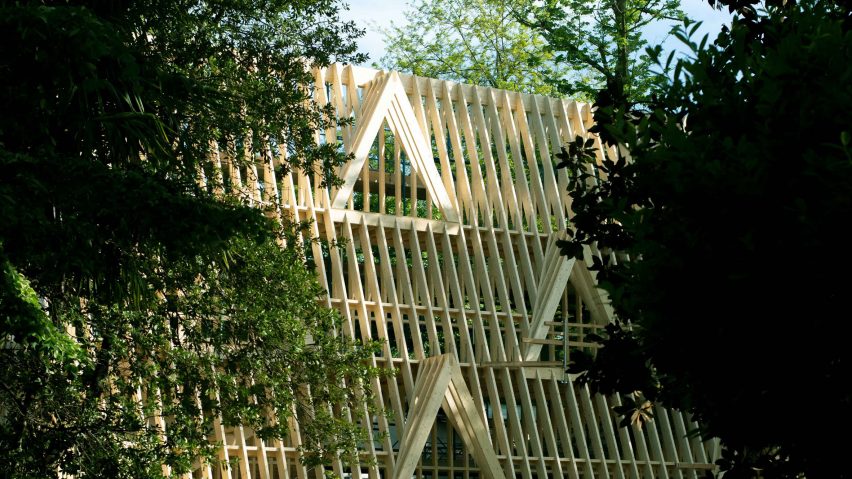American architects Paul Andersen and Paul Preissner have built a four-storey pine frame in front of the US pavilion at the Venice Architecture Biennale.
Called American Framing, the pavilion project was commissioned by the University of Illinois Chicago and explores the history of softwood as a building material in America.
Wood framing is a construction method where pieces of wood are fitted together to form a support structure, or skeleton, for a building.
It is ubiquitous in America, where early settlers found an abundance of pine and fir. Across the midwest, they developed construction methods to exploit the cheap material that did not require sophisticated carpentry skills.
Andersen and Preissner built traditional features of American houses, such as dormers, gables and a porch, into a 12-metre-tall wooden skeleton made from pine sourced from Austria.
The structure and the accompanying exhibition inside the neoclassical pavilion reveal a construction method that usually remains hidden and is largely uncelebrated, the architects said.
"It started with a conversation about how beautiful projects can be when the framing has been built, but not covered," explained Andersen.
"It seemed a bit mystifying to us that other than in carpentry guides and a handful of academic texts, the subject was never explored with the seriousness as nearly all other types of architecture," added Preissner.
According to Preissner, timber framing currently accounts for over 90 per cent of domestic construction in America due to the availability and low cost of the material. The duo wanted to bring this to Venice with their pine installation.
"The full-scale work expresses the sublime and profound aesthetic power of a material system that underlies most buildings in the United States," Andersen told Dezeen.
"We hope that the experience of the pavilion reconditions attitudes towards the widely used but unprivileged construction method, and introduces the topic anew, presenting the vaguely familiar as something profoundly wonderful," added Preissner.
The pair also want to highlight wood as a sustainable building material.
"It's better for the environment than concrete, steel, masonry or old-growth timber," Andersen. "Plus, you're growing trees while you make it."
American Framing also features matching wooden furniture by architect Ania Jaworska and architecture practice Norman Kelley.
Norman Kelley has remade Shaker chairs and benches using softwood and nails, while Jaworska's pieces are benches crafted from pre-cut lumber.
Photography by Daniel Shea and Chris Strong documenting the US timber industry is also shown as part of the exhibition.
Shea documents fir and pine forests where trees used for lumber grow, while Strong's photography focusses on the people who work around mills, shops and construction sites.
"The photographic projects examine the margins of the wood framing world, either through the exploration of the temporal site of construction and the social and political aspects of labour or through the textures, myths and origin stories of the material itself," said Preissner.
Paul Andersen and Paul Preissner are both independent architects and associate professors at the University of Illinois Chicago.
More nature-themed pavilions at this year's Venice Architecture Biennale include a rainwater installation inside the Danish pavilion and a co-living space built out of spruce inside the Nordic Pavilion.
Photography is by Paul Andersen and Paul Preissner.
American Framing will be on display in the Giardini as part of the Venice Architecture Biennale, which takes place from 22 May to 21 November 2021. See Dezeen Events Guide for all the latest information you need to know to attend the event, as well as a list of other architecture and design events taking place around the world.

